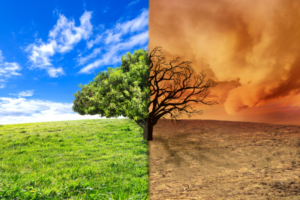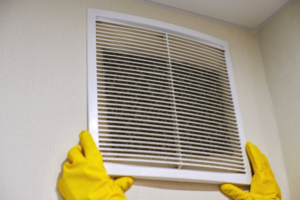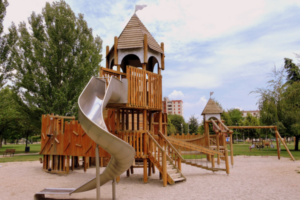Most people don’t give a second thought to mold when they think about outdoor play areas and recreation zones. After all, these are open-air environments, constantly exposed to sunlight and fresh air. So how could mold even be a problem? But that thinking is exactly why mold in outdoor recreational structures is often left unchecked. From park benches to pavilions, wooden playground sets to metal bleachers, these installations are backed by years of community use but not always regular upkeep. That’s where mold sneaks in and slowly becomes a problem you didn’t know existed—until it’s too late. In this article, we’re focusing on how mold becomes an issue, what kind of damage it can do, and, most importantly, how proper recreational structure maintenance and a few good habits in outdoor mold prevention can make parks and community areas safer and healthier for everyone.
Mold Doesn’t Care That It’s Outdoors
One common misunderstanding about mold is that it’s something only indoor spaces need to worry about. After all, mold loves dark, damp, enclosed spaces, right? Well, yes — but it also loves neglected wood, shaded corners, and areas that stay damp even under the open sky. Outdoor recreational structures, like children’s playgrounds or community pavilions, often fit that description more than we like to admit.
Think about it. That shaded roof above the picnic tables? It rarely sees direct sunlight and often collects moisture, especially during rainy seasons. Those wooden rails on the back of a bench? If they aren’t sealed correctly, water can soak right into the grain, giving mold all it needs to make a comfortable home. Metal isn’t off the hook either. Rusty bolts, peeling paint, and pooling water on uneven surfaces can promote enough dampness to start mold colonizing. Since these structures are exposed year-round to weather patterns, organic material from leaves, precipitation, humidity, and even dirt create ideal growing conditions.
Why Recreational Mold Matters
Unlike indoor mold, which is often caught quickly due to noticeable smells or visible damage within living spaces, outdoor mold frequently hunkers in unnoticed areas. It might be tucked underneath slides, within joints of picnic tables, or deep in the grooves of wood structures. Because these areas aren’t always part of the daily check or cleaning routines, mold has time to mature and expand into a bigger problem.
But why care? For starters, mold exposure—even outside—can be a real health hazard. Especially for children, seniors, or those with allergies or asthma, exposure to mold spores can cause respiratory reactions, itchy skin, watery eyes, and even infections for those with compromised immune systems. When we’re talking about playgrounds and public parks, these are places where community members gather, relax, and let their kids roam free. They should be safe zones, not sites of hidden health risks.
Beyond health concerns, mold contributes to physical deterioration. It eats away at wooden structures, breaks down paint, weakens bolts, and promotes rust on metal surfaces. Left unchecked, this type of damage can create safety risks like collapses, splinters, and tripping hazards. Not exactly what you want in a place where kids are supposed to safely play.
How Mold Takes Hold Outdoors
Outdoor mold doesn’t need much encouragement to get going. In fact, many outdoor recreation structures provide precisely what mold needs. Whether the structure is made of treated wood, painted metal, or plastic components, mold spores can settle and grow when moisture and minimal sunlight are involved. Here are some common contributors:
Poor drainage: If water tends to puddle around or on structures, especially after rain, this lingering moisture gives mold a base.
Natural debris: Leaves, algae, and dirt that settle on play surfaces or bleacher seats can trap moisture and feed fungal growth.
Lack of sealing or protection: Outdoor materials are often painted or treated for protection, but over time, those layers wear off, giving mold places to settle in naked surfaces.
Low maintenance: Many public recreation areas are visited more than they’re cleaned. Mold takes advantage of this neglect, growing steadily when no one’s watching.
Outdoor Mold Prevention that Actually Works
The good news? There are several tactics that can help turn the tide on mold buildup in outdoor recreation spaces. The key is regular attention. Mold might be sneaky, but it’s not unbeatable. Mold in outdoor settings can be addressed by staying a few steps ahead of the conditions that trigger growth.
Routine maintenance schedules should be part of any municipality or property manager’s operational checklist. Just like mowing the grass or emptying trash bins, cleaning and inspecting structural surfaces for mold should happen throughout the year, especially in wetter seasons. Pressure washing at a safe PSI can help regularly clear grime and organic buildup from surfaces without harming materials.
Surface treatments make a huge difference. Wood installations should be stained or sealed, ideally with mold-resistant products that add a barrier to spores. For metals, paint or powder coatings offer protection. The goal is to keep surface permeability low so mold cannot gain an easy hold.
Drainage assessments are also key. If rainfall isn’t flowing away from facilities, it can cause ongoing puddles and mud traps that feed mold. Simple landscaping modifications to redirect water flow can prevent the kind of damp build-up where mold thrives. Look at where downspouts discharge, where foot traffic compacts soil, and where water might creep back into shaded spots.
Shading and drying balance is another area worth attention. While complete exposure to the sun isn’t always possible, pruning nearby trees and ensuring some airflow around structures can limit how long surfaces stay wet. Less shade equals quicker drying, which limits mold’s chances for growth.
Who’s Responsible for Keeping Mold at Bay
Now, here’s the part few people talk about. Because these structures are usually not inside someone’s home or directly within a store, accountability for keeping them mold-free tends to fall through the cracks. In city environments, these duties typically land with parks departments or building maintenance crews. But limited budgets or unclear mandates can lead to lack of action. Meanwhile, neighborhood HOAs or business owners with private recreational structures often overlook preventive care unless damage is already visible.
Private businesses, like daycare centers or sports complexes, often install incredible-looking play equipment or shade structures to attract clients, but if they’re not up-to-speed on mold prevention routines, their liability risk crawls slowly upward. Proper recreational structure maintenance shouldn’t be left to reactionary cycles after things break. Preventive cleaning, sealing, replacing damaged elements, and documenting those efforts help maintain not just cleanliness, but legal strength in case an accident happens due to mold-related damage.
Special Risk Areas
Some structures are naturally more prone to mold, simply due to their shape, materials, or position in the environment. For example, wooden playground towers and multi-level platforms often contain hidden underside areas where water collects and airflow is limited. Picnic areas with canopies or roof pavilions often create long-lasting shade zones, making their surfaces higher risk zones even under clear weather conditions.
Sports seating, especially older outdoor bleachers made from wood or painted steel, are also common problem spots. Dirt collects in corners, supports may trap moisture, and with minimal covering, they experience a rough cycle of sunny exposure followed by cooling and damp nights. Over time, gritty surfaces start to mildew if no one stays on top of cleaning or treating the material.
Mold Removal Tips That Don’t Cause More Problems
When mold is discovered outdoors, the instinct is to go after it with bleach or power washers. While that might seem fast, it’s not always the best long-term move. Bleach can discolor treated surfaces or corrode metals, and improper pressure washing can damage paint, wood grain, or even loosen bolts. Mold removal on playgrounds or bleachers should prioritize safety for both people and the structure itself.
Gentler cleaning solutions using vinegar, diluted hydrogen peroxide, or mold-specific surface cleaners tend to work better for sensitive environments meant for children. Bristle brushes and consistent cleaning do the job without gouging or scarring materials. Once immediate growth is cleared, sealing or repainting damaged areas is the next step in preventing recurrence.
Why This All Matters More Than You Think
So maybe you can’t see the mold until it’s gotten bad. Maybe no one complained, and the equipment still “looks fine.” But mold doesn’t respect laziness, and even in open-air spaces packed with sunlight and movement, it finds ways to root itself into community centers and structures built for fun. Clean-looking doesn’t mean clean-being, and without routine care and attention, outdoor mold can quietly double the risk of illness, injuries, and future repair costs.
At the end of the day, public parks, schoolyards, and recreational areas are meant to serve their communities safely. By including mold prevention and maintenance as a core part of structural care, municipalities and private landowners can keep spaces enjoyable without hidden risks buried under rot and spores. Mold may be sneaky, but it doesn’t have to win.
Recreational structure maintenance is about more than checking for rusted bolts or peeling paint. It’s about guarding what these spaces represent for our towns and neighborhoods. Families trust that park benches are clean, that slides won’t come with unintended allergens, and that bleachers will safely hold spectators from one season to the next.
Through better cleaning schedules, smarter sealing practices, and a little bit of watchful care, outdoor mold stops being an overlooked nuisance and starts being something we can control. After all, when it comes to public health in outdoor spaces, being proactive always beats being reactive.







